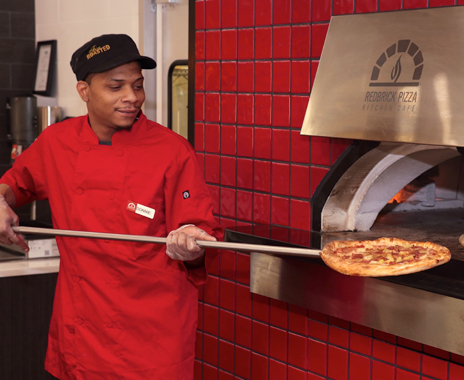Companies have good reasons for acquiring franchise brands. Often they see potential in a brand and hope to use their own resources to build it into a national contender.
Many brands, though, need a healthy dose of TLC after acquisition. And some companies have found that a good rebranding can improve the franchise’s marketing opportunities, employee base, and menu optimization and, ultimately, turn the brand around.
Jim Notarnicola is vice president of marketing and franchising for BRIX Holdings, which helped build Red Mango into a leader in the frozen yogurt industry and, last year, in an effort to invest further in the health-food space, acquired and relaunched RedBrick Pizza, Smoothie Factory, Souper Salad, and Greenz.
Notarnicola says companies looking to relaunch a franchise should see if there is untapped potential in the brand’s existing structure and locations, and should also see how the franchise can be complimented and reinvigorated post-relaunch.
“For example, in the case of Smoothie Factory, their strength was they had built up a business around high-performance smoothies for athletes; they tended to build their stores right next to gyms and they really catered to weight lifters [and] marathon runners [with] very nutritious smoothie formulations. They also sold nutritional supplements,” Notarnicola says. “We saw an opportunity there for that customer base to expand the menu. So we revisited the product assortment and the menu.”
BRIX rolled out a fresh juicing program to Smoothie Factory stores, along with a health-conscious frozen yogurt option. Both products are menu options at Red Mango.
Revamped brands must also be attractive to potential franchisees, Notarnicola adds, which is why BRIX developed new prototypes for RedBrick Pizza and Smoothie Factory. It also implemented financial incentives to attract franchisee interest in the brand. BRIX Holdings offers new franchisees no royalty fee payments for the first six months, as well as the “Super Boost Buyback Offer,” through which BRIX will buy a franchise back within 12 months from unsatisfied franchisees.
“We’re doing things to minimize the risks for new franchisees that we’re asking to relaunch a new prototype,” Notarnicola says.
Brent Dowling, COO at Denver-based franchise consultancy RainTree Franchise Sales & Marketing, says his first priority in relaunching a quick-serve franchise is reinventing the brand’s outreach. Concepts that see little to no growth in sales often struggle to grow their number of franchisees because their outreach efforts are outdated, he says.
“What we find is most brands that have gone through this phase have really struggled in educating and exciting potential franchisees,” Dowling says. “The reason they have struggled is because the methods of educating franchisees and getting them excited has changed; it has shifted considerably in the last three to five years.”
For franchisors to successfully connect with potential franchisees, information must be easily accessible through a content-rich website versus a salesperson-led process, he adds. With the explosion of content in the past three to five years, people prefer self-discovery as a way to learn about a franchise.
“A good franchise website has 30-plus pages of rich and exciting content,” Dowling says. That content could include the franchise’s story or details on current locations, products offered, and investment options. The website could also have a blog that focuses on brand or industry topics. Dowling recommends using video content because it’s more impactful to the franchisee in understanding the franchise’s story.
Equally important to the brand turnaround process is identifying the system’s most valuable players and recruiting their help for the turnaround, says Ben Amante, principal of Costa Mesa, California–based Amante Franchise Consulting. Companies should look at each location’s sales volume to identify three franchise-performance tiers, he says, and once the top-performing franchisees are identified, the new ownership can meet with them and hear their concerns.
“Go out to a few of the major markets and organize a town hall meeting with franchisees. Put aside some time for a day to visit some of the stores, have the town hall meeting late that afternoon, and that evening you’re having dinner with some of those top-performing franchise owners,” Amante says. “Within a week, you could probably meet with 30–40 percent of the chain.”
Another good base to hear from? Customers. After partnering with The Chickery, a Toronto-based fast-casual chicken chain, Dan Rowe, founder and CEO of Alexandria, Virginia –based franchise consultancy Fransmart, found out through social media that a menu change and training reboot were key to relaunching the franchise.
According to social media interactions, Rowe says, customers loved the chicken but didn’t want to spend $13 for a salad or sandwich. To address this, the brand offered half-portion salads and sandwiches for $7. Customers also didn’t like the service at the restaurants, so Rowe used 10-minute, paid, pre-shift meetings to train the staff on things like speed and friendliness, using select comments from customers on social media as training tools.
“We would reach back out to those who gave bad reviews,” he says. “We would say, ‘Yeah, you’re right [about our performance], but this is what we did [to fix our business].”






